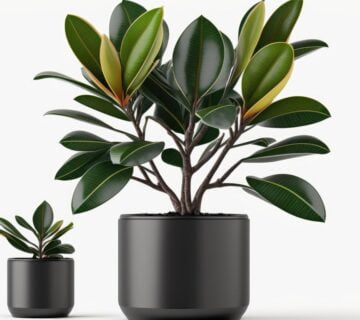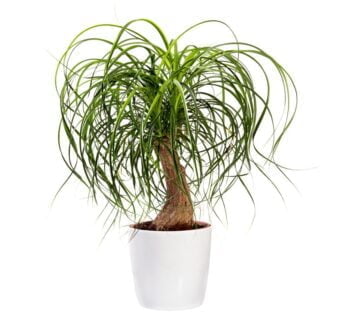Dieffenbachia – DUMB CANE
Dieffenbachia, commonly known as Dumb Cane (Camille), is a popular tropical houseplant known for its attractive foliage and ease of care.
Appearance:
Dieffenbachia plants feature large, lush leaves with unique patterns and variegation. The leaves are typically green with contrasting markings in cream, yellow, or white shades, adding a touch of elegance to any indoor space.
Air-purifying qualities:
Dieffenbachia plants are known for their air-purifying properties. They can help filter and cleanse the air by removing common toxins and pollutants, making them a beneficial addition to any home or office environment.
Easy to grow:
Dieffenbachia is considered a relatively easy plant, making it suitable for beginner and experienced gardeners. It thrives in average room temperatures and can adapt to various light conditions, although it prefers bright indirect light.
Watering requirements:
Maintaining a consistent watering routine for Dieffenbachia is important. Water the plant when the top inch of soil feels dry, but avoid overwatering as it can lead to root rot. Proper drainage is essential to prevent waterlogged soil.
Humidity needs:
Dieffenbachia prefers higher humidity levels, mimicking its native tropical environment. To increase humidity, you can mist the leaves regularly or place a water tray near the plant to create a humid microclimate.
Toxicity:
It’s essential to note that Dieffenbachia contains toxic compounds, including calcium oxalate crystals, which can cause irritation and discomfort if ingested. Keep it out of reach of children and pets, and wash your hands after handling the plant.
Propagation:
Dieffenbachia can be easily propagated through stem cuttings. Cut a healthy stem below a node and place it in a container with a moist potting mix. Within a few weeks, roots will develop, and a new plant will grow.
Pruning:
Regular pruning can help maintain the shape and appearance of your Dieffenbachia plant. Remove any yellowing or damaged leaves and trim back overgrown stems to encourage bushier growth.
Pests:
While Dieffenbachia is generally resilient to pests, it can occasionally be affected by common houseplant pests such as aphids, mealybugs, and spider mites. Inspect the plant regularly and treat any infestations promptly with appropriate insecticides or natural remedies.
Varieties:
Numerous Dieffenbachia cultivars are available, each with unique leaf patterns and colours. Some popular varieties include ‘Camille’ with cream and green leaves, ‘Tropic Snow’ with white and green leaves, and ‘Rudolph Roehrs’ with dark green leaves and prominent white veins.
Air Purifying Qualities:
It is one of the best houseplants in your home because it tops NASA’s air-purifying plant list. It effectively removes harmful chemicals like ammonia, toluene, xylene and formaldehyde.
Dieffenbachia plants are visually appealing and contribute to a healthier indoor environment. With proper care and attention, this stunning houseplant can thrive and bring tropical beauty to your home or office.
Things to know about DIEFFENBACHIA
Common (vernacular) Name
डाइफेनबैचिया (Hindi), Dieffenbachia, Dumb Cane, Leopard Lily and many more.
Botanical Name
Amoena
Origin
Tropics from Mexico and the West Indies south to Argentina.
Family
Araceae
Plant Type
Tropical plant
Plant Features
Ornamental / Evergreen / Exotic
Life Cycle
Perennial
Landscape Uses
Container Planting and Houseplants.
Species
Amoena, Camille, Exotica, Hilo, Maculata, Tropical Tiki, Tropic Snow, X bausei.
Varieties
It comes with thousand of different varieties in a diversity of leaf and flower colorations. Some popular species are available in a myriad of colors and exotic variegation, such as Dieffenbachia aglaonematifolia, Dieffenbachia antioquensis, Dieffenbachia aurantiaca, Dieffenbachia beachiana, Dieffenbachia bowmannii, Dieffenbachia brittonii, Dieffenbachia burgeri, Dieffenbachia cannifolia, Dieffenbachia concinna, Dieffenbachia copensis, Dieffenbachia cordata, Dieffenbachia costata, Dieffenbachia crebripistillata, Dieffenbachia daguensis, Dieffenbachia davidsei, Dieffenbachia duidae, Dieffenbachia elegans, Dieffenbachia enderi, Dieffenbachia fortunensis, Dieffenbachia fosteri, Dieffenbachia fournieri, Dieffenbachia galdamesiae, Dieffenbachia gracilis, Dieffenbachia grayumiana, Dieffenbachia hammelii, Dieffenbachia herthae, Dieffenbachia horichii, Dieffenbachia humilis, Dieffenbachia imperialis, Dieffenbachia isthmia, Dieffenbachia killipii, Dieffenbachia lancifolia, Dieffenbachia leopoldii, Dieffenbachia longispatha, Dieffenbachia lutheri, Dieffenbachia macrophylla, Dieffenbachia meleagris, Dieffenbachia nitidipetiolata, Dieffenbachia obliqua, Dieffenbachia obscurinervia, Dieffenbachia oerstedii, Dieffenbachia olbia, Dieffenbachia paludicola, Dieffenbachia panamensis, Dieffenbachia parlatorei, Dieffenbachia parvifolia, Dieffenbachia parvifolia, Dieffenbachia pittieri, Dieffenbachia seguine, Dieffenbachia shuttleworthiana, Dieffenbachia standleyi, Dieffenbachia tonduzii, Dieffenbachia weberbaueri, Dieffenbachia weirii, Dieffenbachia wendlandii, Dieffenbachia williamsii, Dieffenbachia wurdackii, and many more.
Size
Height : 6 to 8 feet tall and Width : 2 to 3 feet wide when mature.
Indoors or Outdoors
Outdoors : Anthurium can be used outdoors in shady plantings, avoid direct sun light.
Indoors : Excellent plant grow in bright light or indirect light. Best indoor plants for beginners.
Blooming / Flowering
Blooming period is throughout the year.
Flower Colour
It’s come with a contrasting spadix Gold, Yellow, Orange, Pink, White, Green, Purple, Red, Burgundy, Multicolored and Variegated colours.
Lucky Plant
According to Feng Shui, It bring Good Luck in your relationships.
Lighting / Sun Exposure
Bright Indirect Sunlight.
Temperature
Grow best preferably warm temperature above 21°C and can be tolerate max temp. as high as 32°C.
Growth Rate
Anthurium is a slow to moderate growers plant.
Watering
Moderate watering, Mist or over head sprinkler to provide water and to improve relative humidity. Not tolerate overwatering it may cause root damage and yellowing of the leaves.
Fertilizer
Slow-release fertilizer, or a water-soluble liquid fertilizer once or twice in the growing season (Spring through Summer).
i.e. - Cow dung, DAP, Compost, NPK 30-10-10 fertilizer, liquid organic fertilizer etc.
Pruning
Pruning of Anthurium not much is needed. However, trimming away only discolored or dead leaves.
Propagation
Seeds : The best time to sow your Anthurium seeds is in the end of Winter / early Spring but it can't can give good result.
Stem Cuttings : The easier methods of propagation of Anthurium in water or in soil via stem cuttings, and can be done during the warm growing season.
Division : Division of Anthurium can be done in Rainy season, or better in February to March.
Dormancy Period
Month : November to February (winter season)
Shed their leaves and show poor growth, Watering minimally.
Avoid : Propagate, Fertilize and Repotting.
Container
Ceramic Pot, Plastic Pot, Terracotta or Clay Pot is preferred, which ensures good drainage as well as water holding capacity.
Soil Type
A well-drained Loam / Coarse potting soil is recommended as well as water holding capacity. Prevent soggy potting medium.
Our recommendation for potting mix : Equal part mixture of Garden Soil (25%) + Compost (25%) + River Sand (25%) + Cocopeat (25%). You can substitute pieces of Charcoal, Vermicompost, Perlite etc.
Soil pH
Lightly Acidic soil - Ideally 5.5 to 6.5 pH (potential of hydrogen) is recommended for Anthurium.
Repotting
It is advisable to repot the Anthurium every year or two preferably spring to midsummer season.
Maintenance
Low maintenance and easy to grow.
Properties
Toxic or Poisonous to both humans and pets upon ingestion.
Benefits
Excellent indoor air purifier, Anthurium plants turns CO2 into oxygen. It purifies indoor air by removing harmful chemicals like ammonia, toluene, xylene and formaldehyde.
Special Features
Doesn't attract hummingbirds and pollinators like butterflies and bees or wasps.
Infestation / Pests
Aphids, Scale insects, Thrips, Mealy bugs, Spider mites and caterpillars etc.
Diseases / Problem
Physiological Problem : Anthracnose, Leaf Spot and Powdery Mildew.
Bacterial Problem : Bacterial Blight, Bacterial Wilt and Black Nose Disease.
Fungal Problems : Root Rot and Water Mold.
Some Glimpse of DIEFFENBACHIA











No comment